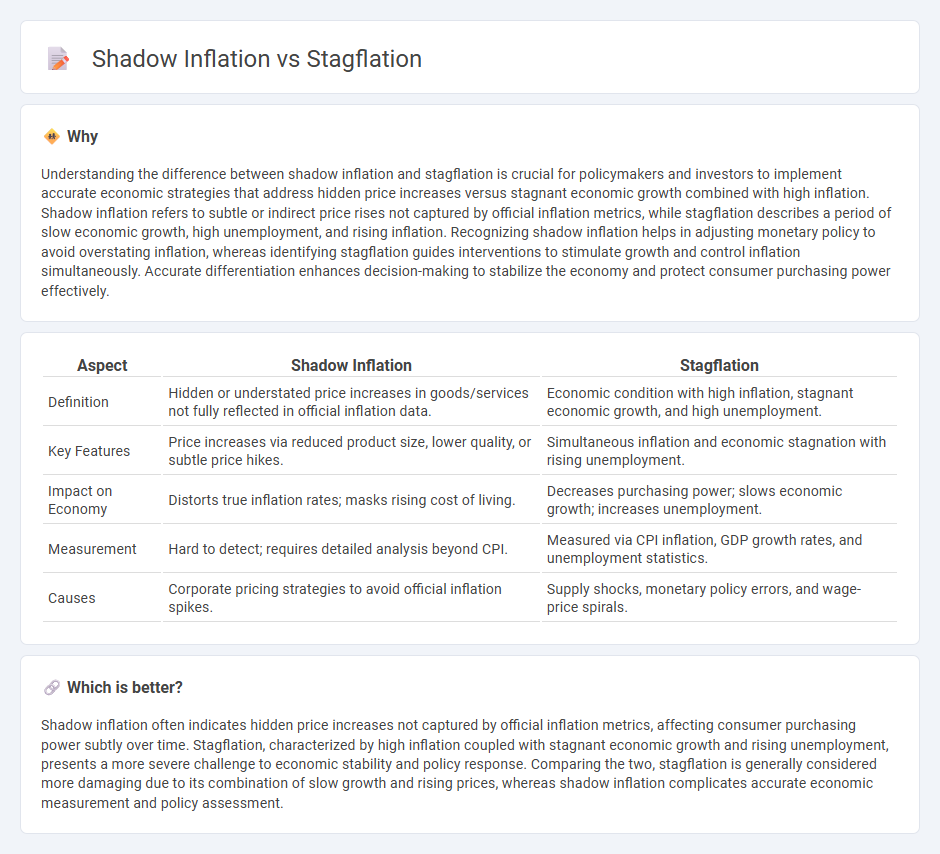
Shadow inflation occurs when the true increase in the cost of living is hidden by changes in product quality or size, misleading consumers about the real rate of inflation. Stagflation combines stagnant economic growth with high inflation and unemployment, creating a challenging environment for policymakers. Explore how these economic phenomena impact market stability and financial decision-making.
Why it is important
Understanding the difference between shadow inflation and stagflation is crucial for policymakers and investors to implement accurate economic strategies that address hidden price increases versus stagnant economic growth combined with high inflation. Shadow inflation refers to subtle or indirect price rises not captured by official inflation metrics, while stagflation describes a period of slow economic growth, high unemployment, and rising inflation. Recognizing shadow inflation helps in adjusting monetary policy to avoid overstating inflation, whereas identifying stagflation guides interventions to stimulate growth and control inflation simultaneously. Accurate differentiation enhances decision-making to stabilize the economy and protect consumer purchasing power effectively.
Comparison Table
| Aspect | Shadow Inflation | Stagflation |
|---|---|---|
| Definition | Hidden or understated price increases in goods/services not fully reflected in official inflation data. | Economic condition with high inflation, stagnant economic growth, and high unemployment. |
| Key Features | Price increases via reduced product size, lower quality, or subtle price hikes. | Simultaneous inflation and economic stagnation with rising unemployment. |
| Impact on Economy | Distorts true inflation rates; masks rising cost of living. | Decreases purchasing power; slows economic growth; increases unemployment. |
| Measurement | Hard to detect; requires detailed analysis beyond CPI. | Measured via CPI inflation, GDP growth rates, and unemployment statistics. |
| Causes | Corporate pricing strategies to avoid official inflation spikes. | Supply shocks, monetary policy errors, and wage-price spirals. |
Which is better?
Shadow inflation often indicates hidden price increases not captured by official inflation metrics, affecting consumer purchasing power subtly over time. Stagflation, characterized by high inflation coupled with stagnant economic growth and rising unemployment, presents a more severe challenge to economic stability and policy response. Comparing the two, stagflation is generally considered more damaging due to its combination of slow growth and rising prices, whereas shadow inflation complicates accurate economic measurement and policy assessment.
Connection
Shadow inflation, characterized by rising costs of goods and services hidden within quality reductions or smaller quantities, contributes to stagflation by eroding consumer purchasing power without corresponding increases in wages. Stagflation, a period of stagnant economic growth combined with high inflation and unemployment, is exacerbated when shadow inflation masks the true inflation rate, complicating monetary policy decisions. This interplay results in prolonged economic stagnation with persistent inflationary pressures that traditional inflation metrics may underestimate.
Key Terms
Inflation
Stagflation refers to an economic condition characterized by stagnant growth, high unemployment, and rising inflation rates, causing real purchasing power to decline. Shadow inflation, on the other hand, represents the hidden rise in prices not fully captured by official inflation metrics, often driven by product downsizing or quality reduction rather than direct price hikes. Explore the differences between stagflation and shadow inflation to better understand their impacts on economic policy and consumer behavior.
Unemployment
Stagflation combines stagnant economic growth with high unemployment and soaring inflation, reducing purchasing power and job opportunities simultaneously. Shadow inflation refers to hidden price increases, often in services or quality reductions, which may not immediately impact official unemployment rates but gradually erode real wages and job stability. Explore how these inflation types uniquely influence labor markets and policy responses for a deeper understanding.
Hidden Costs
Stagflation refers to a persistent economic condition characterized by stagnant growth, high unemployment, and rising inflation, which erodes purchasing power and increases hidden costs for consumers and businesses. Shadow inflation, on the other hand, involves covert price increases embedded in product downsizing, reduced quality, or added fees that mask true inflation rates, silently impacting household budgets without official inflation figures reflecting the change. Explore the nuances of hidden costs in stagflation versus shadow inflation to understand their distinct economic pressures and implications.
Source and External Links
Stagflation Overview, Examples, Why Stagflation is Feared - Stagflation is a rare and challenging economic condition marked by high inflation, slow economic growth, and persistently high unemployment, often leading to policy dilemmas for governments.
What is stagflation? - Stagflation occurs when an economy experiences rising prices, stagnant or negative growth, and elevated unemployment simultaneously, defying typical economic patterns where inflation and unemployment usually move in opposite directions.
Stagflation - Wikipedia - The term "stagflation" combines stagnation and inflation, describing periods when prices rise while the economy stalls and joblessness increases, challenging conventional economic theories like the Phillips Curve.
 dowidth.com
dowidth.com